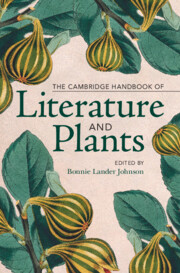Book contents
- The Cambridge Handbook of Literature and Plants
- The Cambridge Handbook of Literature and Plants
- Copyright page
- Contents
- Figures
- Contributors
- Introduction
- Part I Historical Periods
- Part II Anglophone Literary Forms
- Part III Global Regions
- Chapter 12 Plants in the French and Francophone Literary Tradition
- Chapter 13 Early American Plant Writing
- Chapter 14 Plants in the Literatures of Latin America and the Caribbean
- Chapter 15 Plants in the Literatures of Australia
- Chapter 16 Plants in the Literatures of Southern Africa
- Chapter 17 Lotus
- Chapter 18 Plants in the Literatures of India
- Chapter 19 Tree-Rings of Middle Eastern Poetry
- Select Bibliography
- Index
Chapter 14 - Plants in the Literatures of Latin America and the Caribbean
from Part III - Global Regions
Published online by Cambridge University Press: 06 February 2025
- The Cambridge Handbook of Literature and Plants
- The Cambridge Handbook of Literature and Plants
- Copyright page
- Contents
- Figures
- Contributors
- Introduction
- Part I Historical Periods
- Part II Anglophone Literary Forms
- Part III Global Regions
- Chapter 12 Plants in the French and Francophone Literary Tradition
- Chapter 13 Early American Plant Writing
- Chapter 14 Plants in the Literatures of Latin America and the Caribbean
- Chapter 15 Plants in the Literatures of Australia
- Chapter 16 Plants in the Literatures of Southern Africa
- Chapter 17 Lotus
- Chapter 18 Plants in the Literatures of India
- Chapter 19 Tree-Rings of Middle Eastern Poetry
- Select Bibliography
- Index
Summary
Plants have played a central role in cultural imaginaries across South and Central America and the Caribbean. This chapter, organised chronologically from the colonial period to the present, focuses on key literary traditions and/or works from Latin America and the Caribbean that engage directly with plants, including sugar cane, the ceiba pentandra, and rubber. The chapter includes discussion of a number of works in English, Portuguese, and Spanish, including John Grainger’s The Sugar-Cane (1764), Euclides da Cunha’s À margem da história [The Amazon: Land Without History] (1909), and Lydia Cabrera’s El Monte [The Wilderness] (1954). Although the works under discussion belong to different historical, national, and linguistic contexts, recurrent plant-inflected tropes and concerns emerge, including those relating to questions of aesthetics and literary form; cultural identity and belonging; environmental care and destruction; and the complex and ever-evolving relationships between human and non-human worlds.
- Type
- Chapter
- Information
- The Cambridge Handbook of Literature and Plants , pp. 268 - 284Publisher: Cambridge University PressPrint publication year: 2025

